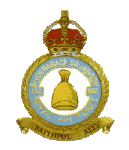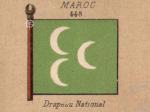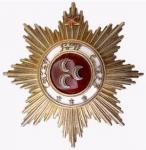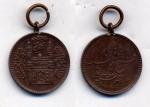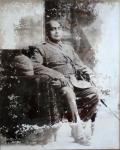
James Hoard
For Deletion-
Posts
632 -
Joined
-
Last visited
-
Days Won
1
Content Type
Profiles
Forums
Blogs
Gallery
Events
Store
Everything posted by James Hoard
-
He was married to King Hussein‘s grand aunt. Bio details from http://www.royalark.net/Arabia/mecca4.htm H.H. Prince Hussein bin Nasser Bey, GCVO (19.7.1966). b. at Taif, Arabia, 30th November 1902 (sixth son of H.H. Prince Nasser bin Ali Pasha, by his second wife, Perendis Khanum), educ. Istanbul Law Coll. Entered Iraq govt service, Private Sec to King Faisal I 1929-1935, attaché Iraqi legation at Ankara 1935-1938, Assist Chief of Protocol at the Ministry of Foreign Affairs 1938-1942, Assist Chief of the Royal Household 1944-1946, Consul-Gen. at Jerusalem and chargé d’Affaires at Amman 1946-1948, transf to Jordanian Foreign Service 1948, Envoy Ext & Minister Plenipotentiary to Turkey 1949-1950, Minister Paris 1950-1951, Jordanian Ambassador to Spain 1953-1961, Lord Chamberlain 1961-1963, 1964-1967, and 1967-1974, Minister of the Royal Court 1963-1964, Prime Minister 1963-1964 and 1967, Senator of the Kingdom of Jordan 1963-1964, 1969-1974. Granted the personal title of Prince (Amir) with the style of His Highness by King Abdullah I of Jordan. Rcvd: GC of the Orders of the Renaissance (special class), Independence, and Star of Jordan, Isabel the Catholic (12.12.1961) and Civil Merit (3.6.1955) of Spain, Christ of Portugal, Merit of the Republic of Italy (31.8.1963), George I of Greece, Defender of the Realm of Malaysia (SMN) (24.4.1965), Star of China, and the Cedars of Lebanon, the Orders of the Two Rivers 1st class of Iraq, Humayun 1st class of Iran, etc. m. at Amman, 1943, H.R.H. Princess Maqbula (b. at Mecca, 6th February 1921; d. at Amman, 1st January 2001), third daughter of H.M. Abdullah I, King of Jordan, GCMG, GBE, by his second wife, H.H. Princess Suzdil. He d. at Amman, Jordan, 1st May 1982.
-
Would anyone have details of the short lived decoration awarded by the British Legation in Persia known as the Royal Victoria Badge? Apparently the decoration was instituted in 1887 under the authority of the Foreign Office by The Rt Hon Sir Henry Drummond Wolff, GCB, GCMG, British Envoy Extraordinary and Minister Plenipotentiary to Persia 1887-1890. The appearance appears to be - head of Queen Victoria on the obverse, surrounded by 16 sharp rays (long) with 16 sharp rays (short) inbetween. The uppermost long ray attached to an Imperial crown (perhaps the small widow's crown worn by Queen Victoria and shown in her later portraits). The crown attached to a loop suspension. Ribbon - a narrow silk ribbon (similar width to a miniature ribbon), red with blue edge stripes, suspended from a broach. Awarded in three classes, gold, silver and bronze, to Qajar princes, high ranking state officials, legation and consular staff and servants. The FO failed to inform either the Prime Minister, the Government or the Queen beforehand and it was therefore "without authority". However, awards having already been made to several high ranking Persians, cancellation was out of the question because it would have ended up in a diplomatic incident. No doubt, the incident blown up and fully exploited by Britain's then rivals in Persia, the Russians, who were busy awarding their decorations left, right and centre. Awards continued to be made until 1903, when Lord Hardinge was eventually forced to divulge the whole matter to King Edward VII because a recipient of the first class was about to make an appearance in London in the entourage of the Shah. On hearing about it, the King was said to be 'surprised'. Though I expect fulminations were more usual from him on such matters. He then immediately issued orders that strict instructions be sent to Tehran that no further awards be made. Known recipients that I have found mentioned in various biographies and diaries are as follows: Lieutenant-General H.E. Shaikh Khaz’al Khan ibn Haji Jabir Khan, Sardar-i-Aqdas, Amir of Mohammerah, GCIE, KCSI - invested in Autumn 1899. General H.H. Shahzada Nuzratullah Mirza, Amir Khan Sardar - date unknown. Nawab Mirza Hasan Ali Khan, CIE - date unknown. Haji Muhammad Ali Behbehani, Rais ut-Tujjar, CIE - 13 January 1903. Prime Minister of Mohammerah. Probably the last recipient. I have never come across an actual physical specimen and have only seen them in black and white photographs. Here are a couple that I could find. Image of the Royal Victoria Badge blown up from the portrait of Prince Nuzratullah, Amir Khan Sardar . Prince Nuzratullah, Amir Khan Sardar wearing the decoration. Shaikh Khaz’al Khan ibn Haji Jabir Khan, Sardar-i-Aqdas, Amir of Mohammerah wearing the decoration. Almost any snippet of additional information would be welcome. [PS: could a moderator be so very kind and cross post this to the section which covers Iran, as I have no idea how to do that. Thanks.]
-
China The Order of Rank and Merit: Its Origins, Classes and Recipients
James Hoard replied to JapanX's topic in China
A small addition to this excellent topic, a picture of Prince Tsai-t'ao [Zaitao], 3rd Prince Chung, wearing the insignia of the Badge on his right breast ca 1909. http://img8.ph.126.net/8xuV_vwtWDcr8mq6arUxBg==/93168217308806808.jpg -
Hawaii - medals
James Hoard replied to James Hoard's topic in Rest of the World: Militaria & History
I would normally. But it was four separate items and its too much effort if its all going to be deleted again. I want the forum administrator's comments first. -
Hawaii - medals
James Hoard replied to James Hoard's topic in Rest of the World: Militaria & History
I made several separate posts yester day about the Order of the Crown and Cross, the Order of Arossi, the Klakaua Jubilee Medal and the Queen Kapiolani Medal. All deleted. No explanation and without so much as a by your leave. Why was this done? -
Does anyone know if these decorations were actually instituted? I know that Worth made proposals but, as far as I can see, none bar the King Abdallah II Medal of Excellence may have actually come into fruition. Thanks
-
Emmanuel, Thanks for the interesting "Surakarta" decoration with the Kelantan style crown. There is a sort of pseudo set of decorations supposedly from Surakarta. But actually the whole show is run by a group of Malaysian 'gong hunters'. Everything is done according to Malaysian norms - titles, classes, names, insignia. Hardly anything Javanese about them. So I am not surprised with the appearance of this insignia. Cheers, James
-
Thanks JDM. While I have seen many pictures of the sultans wearing decorations, where do the dates and names for them come from? What references/sources do you have? As for the website, could you please post the links. Cheers, James
-
Thank you JDM for these very interesting posts on the Indonesian Sultanates. However, do you have any actual contemporary references or sources for them? The more recent crop of Surakarta orders, as you know, are the result of a Malaysian money making exercise. Scanty information on old orders was loosely grafted on to modern creations of a very Malaysian style, titles, etc. Often with little or no relation to the real decorations. Recipients purchase their decorations for a fee, though somehow the former prince was induced to preside over the investitures. Probably also for a fee to lend some loose credibility to a dirty business. I fear that these decorations for Pontianak, Sambas, etc, may be of the same calibre. Cheers, James
-
Obverse and reverse. Both sides are fully enamelled. The obverse has a depiction of St Michael, the reverse has St George.
-
Owain, it is all a Western media plot engineered by Israel anyway. Cheers
-
I have since been informed that a second Hyderabad gift squadron also served in the Tunis campaign during the period November 1942 - March 1943, i.e. 152 (Hyderabad) Squadron RAF. They were commanded by a Squadron Leader John Eric James "Jackie" Sing, DFC and, apparently, flew "Rhubarbs"
-
Owain, Your answer is very interesting because my respondents are three Egyptians, two Saudis, two Tunisians (and one Turk to ensure it wasn't Osmanlica). They all agree that the calligraphy is abysmal. Cheers, James
-
I have had a few more discussions with various North African Arab friends of mine about this Rothe "Red Star of the Arabs" decoration. Several pointed out that the Arabic inscription is in a very bad calligraphic style which somehow resembles Moroccan scripting. Then another one says that he can possibly make out that it reads "el Hilal el Ahmar el Maghribi" (Moroccan Red Crescent). A third came up with this version of a Moroccan flag which was used until 1915 which, although on a green field, shows the use of the three crescents.
-
I have done a little bit more research on this medal from the former Indian princely state of Hyderabad and thought I would share it here. Tony McClenaghan, who wrote about Indian Princely Medals, has incomplete information and an incorrect date. The Victory in Tunis Medal was instituted by the Nizam of Hyderabad to commemorate the British victory in North Africa. Although Hyderabad troops did not take part in the Tunis campaign, No 253 Squadron RAF (Hyderabad) took part in the battle for Tunisia, providing fighter cover for the army October 1942-October 1943. The squadron was closely associated with Hyderabad as the Hyderabad gift squadron, and had been equipped entirely with new aircraft by the Nizam of Hyderabad, who was also the squadron patron. The Medal is dated 17th Tir 1352 Deccan Fasli. However, Tony McClenaghan miscalculated the date conversion to 7th May 1942. Tir 1352 according to the Deccan Fasli calendar went from 6th October 1942 to 5th October 1943, so the correct date is May 1943 (not 1942), and thus ties in with the Allied Victory Parade at Tunis on 24th May 1943. Three classes are known - silver, bronze and copper. The copper medals were distributed as souvenirs to school students personally by the Nizam in Hyderabad. It is not known to whom the other classes were distributed, but one can assume that at least the members of 253 Squadron must have received them. Cheers.
-
Indeed, exceptions to the rule are thrilling. There is also the famous Lieutenant-Colonel Stephen Blucke, a free black man from the West Indies who commanded British black units in the American War of Independence as a Captain, and then led them to settlement in Nova Scotia, where he became a Lt-Col in the local militia. Unfortunately, he went into the wilderness one day and was, apparently, eaten by a bear. West Africa was rather interesting. The Whities used to die like flies because of the local conditions, so the educated locals did comparatively well. There is a lovely photograph of a garden party from either Ghana or Sierra Leone with local white big-whigs (memsahibs attached) walking along doffing their hats at fellow black, equally besuited with their own memsahibs attached. The mother of the acting Governor of Sierra Leone at the time of the proclamation of the abolition of slavery had actually been a slave. Oh, there were Parsee MPs in the House of Commons in the 1890s. Sir Muncherjee Bhownagree was a Conservative to boot. I wonder if you may be right and the medal could be Masonic. I think members of the Singh Roy family are even today quite heavily involved.
-
Peter Yes, I was thinking the same. That it was probably a rifle regiment. I first thought Sherwood Foresters, but their Maltese cross is much more slender and the crown much smaller. The medal seems to have a broad central stripe with two edge stripes. However, the size of the medal is somewhat puzzling. It seems to be something in-between miniature and regular size. Neither the Bengal Indian Association (basically a trade union for Zamindars, or large landlords) nor the Royal Society of Arts in the UK are any help, apart from giving his rank as part of his title and name. Although you are "generally" correct about non-white officers in the 1850s, at that time there were actually two West African colonels in the British Army at that time. Cheers, James
-
I have been trying to trace service details for a Major Chukkun Lal Singh Roy, from the Chakdighi Zamindari family in the Burdwan district of Bengal. The family "claim" that he served in the Crimean War. But quite obviously the uniform is late nineteenth century, possibly 1880s. I have had no success tracing him in the Army Lists.The different spellings and combinations of his name make this a huge problem. I have found him listed in the Journal of the Royal Society of Arts (GB) 1899-1901 as "Major Chucken Lall" and as "Major Chukkan Lall Singh Roy" in the Chronicle of the British India Association (Bengal) 1851-1952. He is also variously given as Chucken Lall Sing, Chukken Lal Roy, Chukanlal Roy, Chucken Singh Roy, etc, etc, The badge on his tropical helmet suggests a British Army regiment rather than Indian. Would anyone be able to identity the unit? Or, indeed, aby further details about this gentleman. Cheers.
-
Albania- Wied era medals
James Hoard replied to James Hoard's topic in Southern European & Balkan States
The first and second medals Meleq Frasheri is wearing are the AH Signum Laudis (Militär-Verdienstmedaille=Medal for Military Merit) in silver and bronze with the crossed swords for war service. -
Malta Republican medal, Malta (Independence? Merit?)
James Hoard replied to taras's topic in Southern European & Balkan States
Malta became an independent member of the Commonwealth on 21st September 1964. > -
New Order for Tonga
James Hoard replied to James Hoard's topic in Rest of the World: Militaria & History
I think I remember seeing the original on the Prime Minister's website, but can now only find the Jubilee stamps. Not very clear, alas. http://commonwealthstampsopinion.blogspot.com.au/2012/03/tonga-commemorates-diamond-jubilee.html Cheers -
Sorry to disagree with you Peter, but much of what you have said conforms to the general thrust of anti-colonial literature but simply is not true. There were Malay Officers in the HEIC forces as early as the seventeenth century, and Malays served as such until the regular Ceylon and Malay Regiments were dissolved in I think the late 1850s or 1870s. The first Indians to be appointed to the rank of full General were in 1877. The heads of the British (Indian) diplomatic missions after the second Afghan War were Indian Muslims of the rank of Lieutenant-Colonel. The officer corps of Indian Medical Service of the Indian Army was long open to Indians. All senior Viceroy's Commissioned Officers held Honorary rank below that of field officers. It one looks further afield, Black West Indians served as officers in the British forces during the American Revolution. Stephen Blucke, from Barbados who served as a Captain, later led those ex-soldiers who settled in Canada. He was promoted to Lieutenant-Colonel in the local militia in 1784. Alas, he went out into the wilderness one day and was eaten by a bear. There were several others under him, but their names escape me for the time being. I know of at least two full Colonels, originally from the BWI, but who served in the medical service in West Africa in the 1850s - one of whom was appointed a Companion of the Order of the Bath - but again, their names escape me. As for the Victoria Cross, that was opened to Indian Army officers, Viceroy's Commissioned Officers and other ranks by King George V and announced by him in person at the Imperial Durbar in 1911. Until then, they were eligible for the Indian Order of Merit, established in 1837 - 20 years before any such gallantry decoration was instituted for the British Army. The Indian Order of Merit was highly prized. One rose up the ranks from third to the covetted first class by performing further acts of gallantry, unless the act was exceptional. If of the standard of the VC, they would receive the first class - made of pure gold and beautifully enamelled - not the remnants of an old iron cannon presented in a carboard box! [in addition to the IOM, Viceroy's Commissioned Officers were eligible for the Order of British India in two classes. Several also received the Order of the Indian Empire after 1877]. I doubt if any other ranks in the British Army were eligible for any class of any order until the Royal Victorian Order was instituted in 1896 and the Order of the British Empire in 1917. Being black does not come into it. William Hall, born in Halifax, Nova Scotia, of freed slaves who escaped the USA, joined the Royal Navy and won his VC for action in the Siege of Lucknow in 1857. It is easy to miss Black people when they have English or European names, as many do, but they have been awarded the VC since its very inception. One of the problems with commissions was one of perception. The forms required one to state if one's parents were British Subjects. Too many fools took that to be a racial question, when it was actually a legal one, answered in the negative and that was that. Few, except those who may have studied law, had the wherewithal to answer yes, as one West Indian who went on to reach the rank of Group Captain in the RAF, DSO, DFC and bar. No doubt to the great chagrin of the prejudiced recruiting staff.
-
Albania- Wied era medals
James Hoard replied to James Hoard's topic in Southern European & Balkan States
Wow, I didn't imagine that they had donated Heaton-Armstrong's portrait as well. Doesn't he look a dashing fellow? I suppose he must have received his Russian medal sometime later. Cheers, James -
Albania- Wied era medals
James Hoard replied to James Hoard's topic in Southern European & Balkan States
Wow! Wuite magnificent. Now I see that the whole of Armstrong's artifacts have been secured for the nation for posterity. Many, many congratulations and best wishes, James

